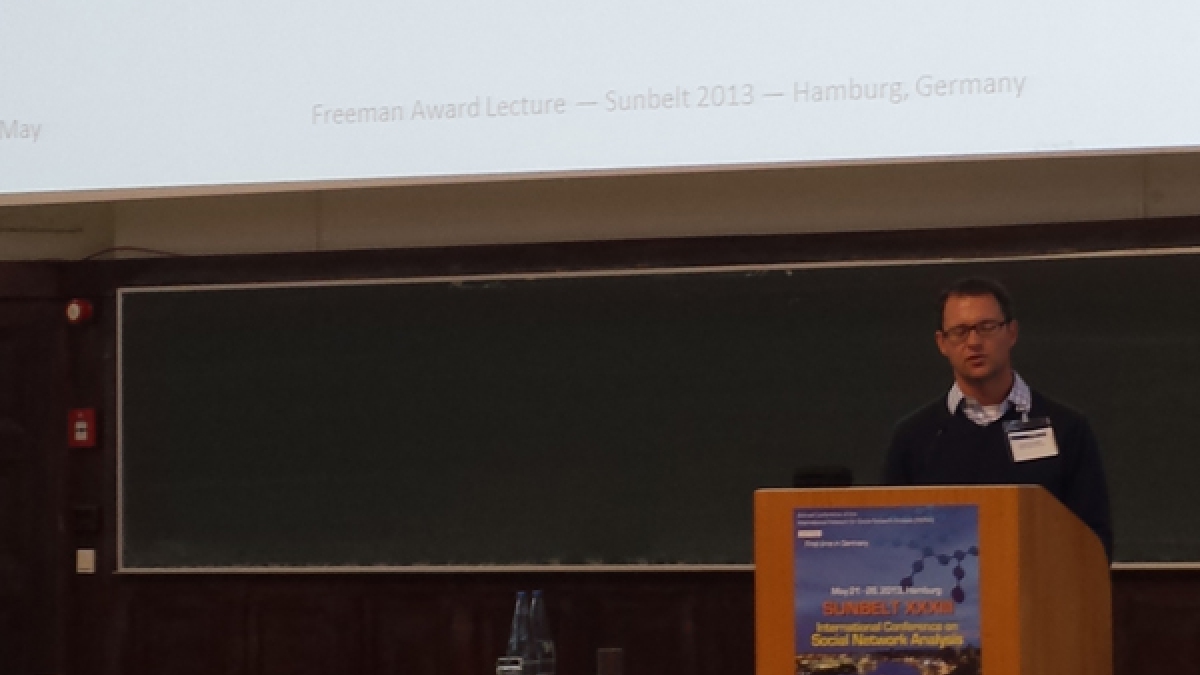Sociologist has new ideas about why similar people are drawn together

Birds of a feather flock together. But why?
That is a mystery Arizona State University sociologist David Schaefer is trying to solve.
His research, which focuses on defining the dynamics that govern how and why individuals choose their network associates, has earned him the Freeman Award from the International Network for Social Network Analysis.
As the recipient, Schaefer presented a one-hour plenary address at the INSNA’s annual Sunbelt Conference, held last month at the University of Hamburg.
The award is presented every other year to a distinguished, up-and-coming scholar “in the field of social networks for significant contributions to the scientific study of social structure.”
Schaefer is an associate professor in the School of Human Evolution and Social Change in the College of Liberal Arts and Sciences.
His exploration of friend selection processes and the origins of social network structures leads him to a variety of outlying research topics, including issues of health and inequality. But at the core of his work is the desire to understand why people often associate with those like themselves, a phenomenon known as homophily.
While the widely accepted reasons for homophily are preference and availability, Schaefer has his own ideas. He suggests that people often have the opportunity and desire to associate with people unlike themselves, yet maintain homophilous relationships.
“I have developed two new explanations that emphasize the endogenous sorting process whereby the relationships individuals develop are not necessarily with their ideal partners,” he says.
In the first case, he points to individuals who withdraw from social activity and form friendships with peers who are also marginalized in social networks.
In the other scenario, individuals who are excluded by their peers based on a particular trait, such as obesity, tend to find friends who are similarly excluded based on the same trait.
Schaefer sums up, “Both processes lead to homophily, but in neither case is it sought by the individuals involved. I tested these mechanisms in one study and found evidence that the former explains depression homophily among adolescents.”
Schaefer investigates a variety of ways in which social networks affect health outcomes, particularly regarding adolescents. His work, much of which is funded by the National Institutes of Health, has led to a number of discoveries.
“In one study, colleagues and I found that adolescents in poor health were more likely to occupy isolated or otherwise marginalized social network positions over time,” he noted.
Schaefer’s work into peer influence processes indicates that adolescent peers are more important for smoking initiation than for smoking cessation.
In another study, he determined that obesity and friendships are related through both friend selection and peer influence processes.
His most recent research aims to understand how adolescents choose “negative” influences. In particular, he is looking at what may lead adolescents to select friends engaged in substance abuse.
“I draw upon theory in criminology that implies adolescents with weak attachments to conventional society, such as parents, schools or church, are more likely to choose deviant peers,” he explains.
“Findings suggest that these friendship patterns are present, but they do not place adolescents at greater risk for negative influence,” Schaefer says. “Rather, this selection process magnifies the tendency for substance users to select one another as a friend.”
Schaefer has published and presented widely. The INSNA Committee states that “his papers exhibit originality in the questions addressed and their elaboration, and show excellence in executing and reporting the research.”